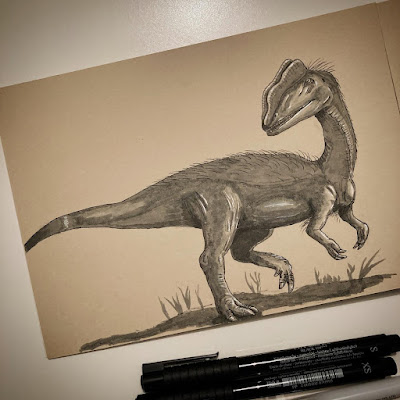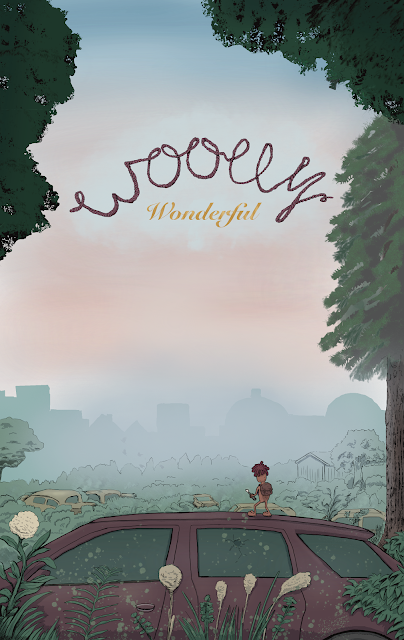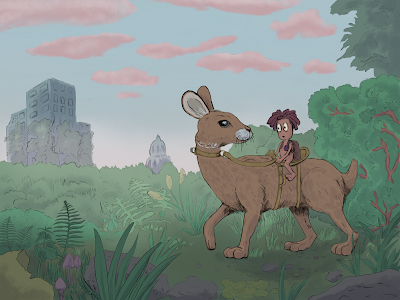Dinosaur drawings this year and Dinovember
Last year I drew a Centrosaurus with ink and grey markers on brown-toned paper. I’ve bought that paper two years ago and never used it properly, but I figured out that it’s quite handy. With a mid-toned paper you only need to care about shadows and highlights because the mid-tone is already provided by the paper itself. On white background you have to establish this mid-tone yourself.
I decide to use this paper block to fill it with dinosaurs drawn in that style.
 |
| Centrosaurus |
Over the past year I tried to fill the pages with some species that I like, not the usual ones that get much media attention.
 |
| Dilophosaurus - without the frill and spitting poison |
 |
| Therizinosaurus |
Technically I discovered some challenges which tampered with my joy:
* I use some black fine liners from Faber-Castell, 0.1-0.3 mm for the outlines or black shadows. These are fine!
* for whites I use a gel pen, probably low quality, as the ink gets stuck from moment to moment and is not flowing constantly and reliably. So the pen makes it really hard to produce clean lines!
* for the shadows I use a set of 4 Pitt Artist Pens from Faber-Castell with Cold Grey I, III, IV and VI. The set is actually 6 pens, but the others are Dark Indigo and a black Soft Brush which I don’t need. Colouring with these is quite a relaxing experience although you have to pay attention not to make any big mistakes. My only complaint would be that the difference between Cold Grey III and IV is that much, so it’s hard to distinguish them in the end result.
Also, grey on brown paper sometimes irritates a bit as it’s hard to achieve smooth transitions. My drawings shown here sometimes have a bit too much contrast.
 |
| Agustinia - an armoured sauropod |
 |
| Saurornithoides |
 |
| Stegosaurus |
 |
| Monolophosaurus |
Basically, the process for these drawings is
1. Sketch with a hard pencil. They don’t smudge that much and don’t mix with the markers later.
2. Once you are satisfied with the proportions, draw the outlines with the pens.
3. Draw in the shadows and markings, starting with the lightest marker and going darker. You can also achieve a darker result with the same marker when you go over the same section a second time. This way you slowly build up the layers.
4. Once the ink has dried, erase the pencil markings outside the outlines. You can leave some of them on the animal in case it helps to build some texture.
One additional thought that came up during this whole year … and maybe the point of this post: how could you draw dinosaurs? If you take extant (living) animals, you either take photographs yourself or from books as references, maybe pictures from the internet or step-by-step guides. Or you are even brave and try to draw from memory.
With dinosaurs it’s not that easy. Pictures in dinosaur books are often out-dated and copied works of other artists. That’s why we tend to see the same poses or animal behaviour for the same animals, I.e. roaring carnivores or Tyrannosaurus fighting against Triceratops just because one artist started with these in the past.
Constructing extinct animals is a highly complicated discipline where artists have to inform themselves about skeletons, skin preservation, ligaments, fat deposits and more to paint accurate depictions. We as layman only have the option to guess or copy which feels kinda cheap if you have high ambitions like myself.
 |
| Troodon |
Despite all that, maybe painting those magnificent animals in full colour would serve better to capture their whole beauty in comparison to a monochromatic semi-comic style. These are just my thoughts to close this challenge and article, when you have some thoughts as well, put them down in the comments!
Cheers,
Andi



Comments
Post a Comment